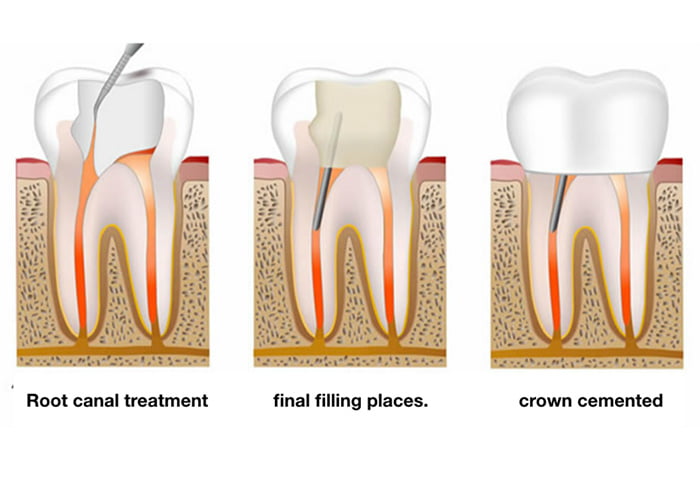Root canal therapy is a treatment used to repair and save a diseased tooth that is badly decayed or infected instead of removing it. The procedure involves removing the pulp inside of the tooth and filling the canal with medication to seal the space.
Your tooth is severely damaged but can be saved, so your dentist recommends a root canal. You do not like getting a procedure without knowing what to expect. You want to know exactly what happens during a root canal treatment. Learn the steps so that you will be prepared for your procedure.
What is root canal treatment (therapy)?
Root canal treatment, a.k.a. endodontic treatment, is a procedure used to save a tooth that has been damaged by decay or infection. The procedure involves removing the damaged tissue from inside the tooth, cleaning and shaping the root canal, and then filling it with a special material.

Root canal treatment can be an effective way to save a tooth that would otherwise need to be extracted. The procedure is usually performed by a dentist or endodontist, and takes one or two visits to complete. After root canal treatment, the tooth may need to be crowned, but it will continue to function like any other tooth.
See more: How Much Does a Root Canal Cost?
Why do you need root canal treatment?
There are many reasons why you might need root canal treatment. If the nerve of your tooth becomes damaged, it becomes infected and can cause a lot of pain. You may also need treatment if you have an infection in your tooth. Sometimes, people need treatment because they have had a root canal before and the original procedure was not done properly.
Steps of a root canal procedure
A root canal therapy procedure is relatively simple. The dentist needs to clean out the infected pulp and fill the canals. Patients usually need a temporary crown after the procedure. Go over each of the steps.

1. Preparing the area
The dentist begins by numbing the area. Injections are used to send the numbing agent into the gums and the tooth’s root. Once the area is numbed, the dentist places a dental dam in the mouth. This isolates the tooth that needs the root canal by covering the rest of the teeth in the mouth.
See more: Wisdom Teeth Extraction in Marrysville
2. Accessing and cleaning the roots
Next, the dentist drills through the tooth to access the root canals and pulp chamber. The dentist uses instruments to clean out the pulp chamber and root canals. An antibacterial and antiseptic solution is used to clean and disinfect the canals. This eliminates the bacteria and treats the infection located in the canals.
3. Shaping the canals
The dentist must place a filling in the root canals. First, the canals must be shaped. The dentist will use tiny instruments to shape the canals, so they will be ready to receive the filling material. Once shaped, the canals are cleaned a second time.
4. Filling the canals
The dentist will use gutta-percha to fill the canals. This rubber-like material is placed inside the canals and then heated. The dentist compresses it, so it fits snuggly against the walls. The dentist adds adhesive cement to further seal the canals. Properly sealed canals keep bacteria out.
5. Filling to the access hole
The dentist must also seal the hole made to access the canals. The filling prevents bacteria from entering the tooth. The dentist also might need to place a post in a canal to strengthen the tooth. This is only necessary if the tooth is severely damaged and cannot support a restoration on its own.
6. Healing and antibiotics
The dentist might send the patient home with a prescription for antibiotics. The medication kills the rest of the infection. The patient will also have post-care instructions. It is normal to experience some discomfort for a few days after the procedure. Over-the-counter pain medications usually alleviate the discomfort.
Read more: How Long Does a Root Canal Take ?
Adding the crown after a root canal
If the root canal was on the back tooth or the tooth has significant damage, the patient will need to come back for a crown. The crown is placed around the treated tooth and adds strength and stability. The permanent crown is fabricated to match the existing teeth. Once placed, the tooth can handle the forces of chewing once again.

What are the risks of root canal treatment?
Root canal treatment is a common dental procedure, but it does come with some risks. The most common complication is inflammation of the tissue around the tooth, which can lead to pain, swelling, and even infection. There is also a small risk of damage to the nerves in the tooth, which can lead to numbness or tingling in the teeth and gums. In rare cases, root canal treatment can cause problems with the jawbone or surrounding teeth.
Are there alternatives to root canal treatment?
The short answer is yes. However, these alternatives are not always ideal and may not be recommended by your dentist. The most common alternative to root canal therapy is an extraction, which is often followed by placement of a dental implant. Other less common options include intentional re-infection of the tooth (aka “nerve regeneration”), endodontic surgery, and vital pulpotomy.
Extraction is usually only recommended if the tooth is severely damaged or decayed and cannot be saved with root canal therapy. Dental implants are considered the best option for replacing a missing tooth but can be costly, so they may not be an option for everyone. Intentional re-infection of the tooth involves drilling a hole in the tooth to allow bacteria to enter and cause an infection.
Do you need a root canal?
If you need a root canal, it is important to act quickly, so your dentist can save the tooth. Your dentist will prepare the area, access the canal and clean it. Then, the dentist will shape the canal, fill it and then fill the access hole. You will need to go home to heal and then you will come back, so the dentist can add the crown.
In summary, dentists can use restoration methods such as fillings and bridges to help patients regain normal eating and chewing function. However, these methods have their own advantages and disadvantages, and the decision to use a specific method depends heavily on each individual patient’s case. If you need to replace a tooth or need support in maintaining good oral health, contact Dentist in Marysville for advice and support. With years of experience and professionalism, the experts at Dentist in Marysville will help you have a bright smile and the best oral health.


